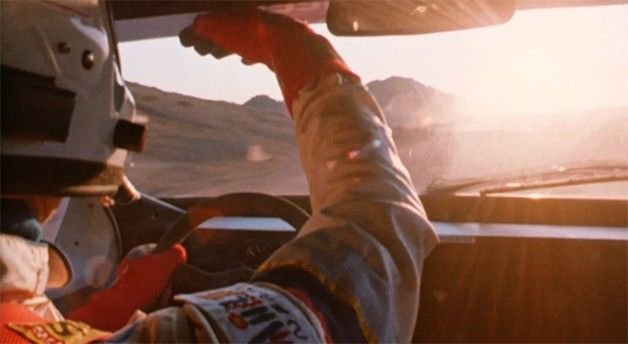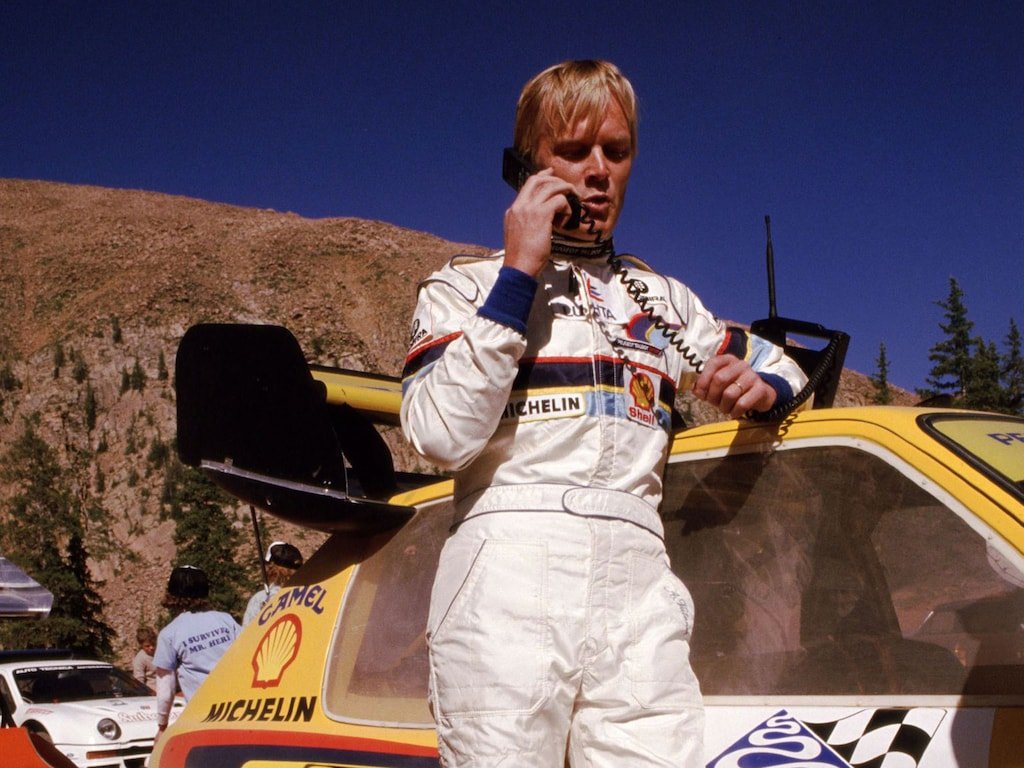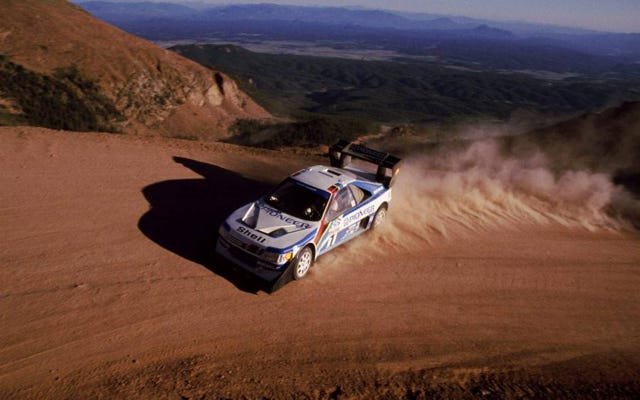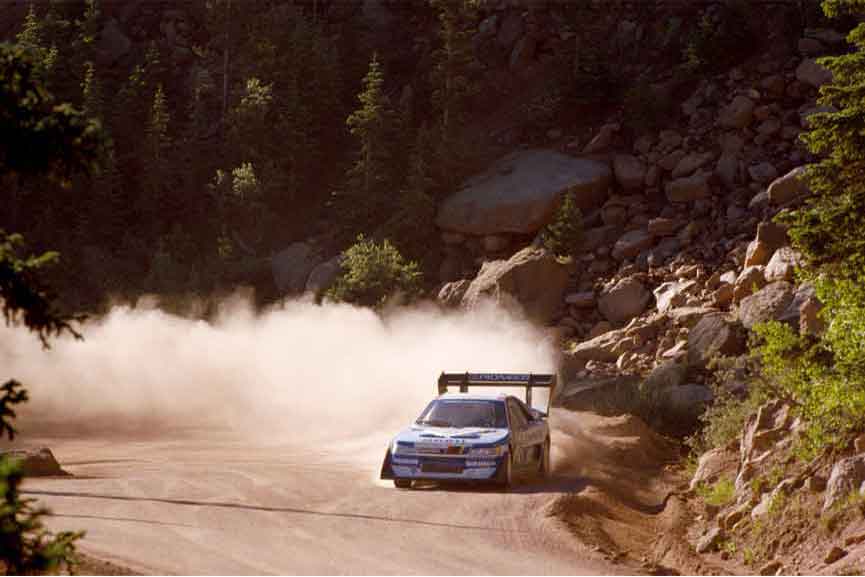How a 6-minute race up a mountain became a cinematic masterpiece of precision, madness, and poetry.
The Hill That Touched the Sky
Setting the Scene: Pike’s Peak, 1988
Before the internet made everything disposable, before algorithmic virality devoured mystery, there was a mountain — a brutal, dusty monument in Colorado called Pike’s Peak. To most people, it was just another summit, 4,302 meters high, wrapped in clouds and arrogance. But to those who worship the smell of fuel and fear, it was a temple.
Pike’s Peak wasn’t built for racing. It was built for gods and fools.
No guardrails, no mercy, just 156 corners of pure contradiction: beauty and terror, altitude and silence, ambition and absurdity. The kind of place that doesn’t forgive hesitation — or ego. It’s the kind of road that eats heroes for breakfast and burps out gravel.
By 1988, Pike’s Peak had already become a kind of myth in motorsport folklore — a high-altitude exorcism where men came to test their limits and occasionally lose their lives. The event itself — the Pikes Peak International Hill Climb, known casually and ironically as The Race to the Clouds — had existed since 1916. But it was only in the 1980s that it turned into a theater of the impossible.
Because that’s what it really was: not a race, but a performance.
A minimalist art piece disguised as motorsport — one man, one machine, one mountain.
No circuits, no audience stands, no comforting laps or redos. Just a single take. A single breath held for ten minutes straight.
And in 1988, a Finnish man named Ari Vatanen showed up with the quiet arrogance of someone who had already seen death and decided to keep driving.
He wasn’t supposed to be there. Not logically. Two years earlier, in Argentina, he had survived a violent crash that nearly ended his life and career. But logic was never part of Vatanen’s driving vocabulary. He came to Pike’s Peak in a Peugeot 405 T16 — a mechanical monster that looked more like a fighter jet with tires than a car — and together, they planned to defy gravity.
Vatanen wasn’t just driving up a mountain. He was attempting a resurrection.

The stage itself was absurd.
Back then, Pike’s Peak was still mostly gravel — slippery, shifting, breathing. Every turn was a negotiation between physics and faith. The altitude sucked oxygen from both engine and driver. The cliffs waited in silence, less like a threat and more like an invitation.
One mistake, and the story ends in an obituary instead of a highlight reel.
But that’s exactly why it mattered.
Pike’s Peak was never about winning; it was about meaning. It was about the kind of control that comes only from surrender — the paradox that artists, dancers, and racing drivers all understand: that mastery begins where comfort ends.
The conditions were surreal. The wind howled like an ancient choir. Dust clung to everything like memory. The sky seemed close enough to touch but far too cold to care. Every corner was a question: How much do you trust yourself?
And every answer came in the form of tire marks and heartbeats.
Watching footage from 1988 today, you almost can’t believe it’s real.
No drones, no CGI, no stabilizers. Just a helicopter camera following a man in a white car carving perfect lines through chaos. The dust follows him like a ghost.
It’s not even clear whether he’s racing or performing a ritual.
There’s something poetic in that — something deeply human.
Because Pike’s Peak isn’t really about cars or times or records. It’s about the aesthetic of control: the choreography of precision against uncertainty.
It’s what ballet would look like if tutus were replaced by turbochargers.
Every great piece of art needs its antagonist, and in this story, it’s the mountain itself. Pike’s Peak doesn’t roar; it watches. It doesn’t need to move — it knows it will win in the end. Every car that climbs it eventually turns to dust, just like every artist, every athlete, every poet who ever thought they could outrun mortality.
But for a few minutes in 1988, Ari Vatanen made the mountain blink.
There’s a moment — if you’ve seen Climb Dance, you know it — when Vatanen takes one hand off the wheel to shield his eyes from the sun as he accelerates toward a corner. That gesture alone is worth more than any victory speech. It’s pure defiance, elegance, and madness all in one. The kind of move you can’t choreograph. The kind of move that belongs in a gallery, not a racetrack.
If you strip it of context, it’s easy to see why this climb has transcended motorsport.
It’s not just driving — it’s storytelling through momentum.
The mountain becomes stage, the car becomes brushstroke, and the driver becomes both artist and sacrifice.
Vatanen’s run at Pike’s Peak wasn’t a victory lap. It was a dialogue between man and nature — one written in speed and dust instead of words. And when he reached the summit, it wasn’t about time. It was about proof. Proof that art can exist anywhere — even in the deafening scream of an engine.
Pike’s Peak is still there, of course, but it’s different now. Paved, civilized, sanitized for modern sensibilities. The myth is archived in HD. The danger is gone.
But 1988 remains untouchable — a frozen moment when courage looked like choreography, and when a Finnish rally driver turned a mountain climb into a timeless work of art.
Ari Vatanen: The Man Who Tamed Chaos
From Rally Stages to the Edge of Existence
To understand what Ari Vatanen did at Pike’s Peak, you first have to understand the kind of man who could do something like that.
You can’t fake control on the edge of oblivion. You can’t bluff gravity. You either have the madness — or the grace. Vatanen had both.
He was born in 1952 in Tuupovaara, a small Finnish town that sounds like the setting of a quiet fairy tale. Except, instead of wizards and dragons, Finland produces rally drivers. Ice roads instead of castles. Silence instead of noise. And in that silence, young Ari learned the first law of Nordic genius: never talk too much — let your hands speak on the wheel.
There’s a certain breed of Finn — stoic, dryly humorous, quietly defiant — that seems engineered for motorsport. Vatanen was one of them, but even among his peers, he stood out. He didn’t just drive fast; he danced with the road.
When others fought their cars, he seduced them.
He wasn’t the most technical driver. He wasn’t even the most disciplined. But he was the most alive.
And that made him dangerous — because you can’t compete with someone who treats fear as a creative collaborator.
By the time he reached Pike’s Peak, Vatanen was already a legend in rallying.
He’d won the 1979 World Rally Championship, driving for Ford, with a combination of precision, instinct, and complete disregard for self-preservation.
To watch Vatanen drive was to watch control flirt with catastrophe. His cars rarely looked stable — they were always sideways, always dancing, always about half a second from disaster.

But that was the point.
Rallying, unlike most motorsport, rewards chaos. You’re racing on ice, mud, gravel — in forests, on cliffs, through rain, snow, and night. There are no laps. No safety barriers. Just raw improvisation.
You drive not to dominate the terrain, but to negotiate with it.
That’s the artistry of rally — it’s a conversation, not a conquest. And no one spoke that language like Vatanen.
But behind the myth, there was always the man — and the scars that built him.
In 1985, during the Argentine Rally, Vatanen’s car crashed at over 100 miles per hour.
It wasn’t cinematic. There was no slow motion, no heroic soundtrack. Just violence. He suffered severe internal injuries, broken bones, and a shattered leg. The car was destroyed. His career, they said, was over.
But again — logic never applied to him.
He came back two years later, slower perhaps in body, but faster in spirit. He once said that after the crash, every drive felt like a gift. That’s what makes his Climb Dance run in 1988 so transcendent — it’s not the act of a man chasing glory, but of someone savoring life in its rawest, most dangerous form.
The climb was both his resurrection and his rebellion.
Vatanen was also strangely philosophical for a rally driver.
He often spoke about driving in the same way painters talk about color or musicians talk about silence. For him, racing wasn’t about machinery — it was about rhythm.
He said once:
“The car is an instrument, and when you’re in harmony with it, it sings.”
That’s not bravado. That’s poetry in grease and dust.
And when you watch Climb Dance, you can hear that symphony: turbo whine, gravel spray, heartbeat.
He was also deeply human. He had flaws, contradictions, moments of fragility that made his brilliance more believable. He was never a perfect machine like some modern drivers — he was an artist. The difference is simple: machines win. Artists endure.
The footage of Vatanen’s run, captured by French director Jean Louis Mourey, turned him into something else — not just a driver, but a cultural symbol.
In Climb Dance, he looks serene. Focused, yes, but not strained. You can see his hands move like a conductor’s, his eyes dart, his breathing synchronized with the car’s pulse. He shields his face from the sun with one hand while steering with the other — and it feels like he’s not defying danger, but inviting it in.
There’s no fear there. No panic. Just trust — in his car, in his instincts, in the choreography of chaos.
It’s what separates him from everyone else. For most people, driving is about control. For Vatanen, it was about surrender — a higher form of control, one that only comes when you’ve accepted that you might not make it.
It’s not bravado. It’s peace.
In Finland, they have a word for that kind of spirit: “sisu.”
It roughly translates to courage, endurance, resilience — but it’s deeper than that. It’s the quiet strength to keep going when reason tells you to stop.
Vatanen was sisu made flesh.
He carried that same stillness into every curve, every jump, every impossible recovery. Even when he lost, he seemed to win something greater: dignity.
After Pike’s Peak, his legend only grew. He went on to race in the Paris-Dakar Rally — another theater of dust and death — and won there too. But no matter how many trophies came after, that climb defined him.
Because in those ten minutes, Vatanen wasn’t just a rally driver. He was a man who had already met death, shaken its hand, and decided to take it for a ride up a mountain.
And that’s the thing about icons like Vatanen — they never seem to belong fully to the sport that birthed them.
They spill into culture. They become metaphors.
Like James Dean’s car crash or Basquiat’s graffiti — Vatanen’s Climb Dance transcended its medium. It became shorthand for something bigger: the ecstatic beauty of control on the brink of collapse.
The kind of art that doesn’t hang in galleries — it lives in motion, in noise, in dust.
That’s where Vatanen lived too.
Climb Dance: Cinema, Myth, and the Poetry of Motion
When a Rally Became a Masterpiece
There are motorsport videos — and then there is Climb Dance.
Filmed in 1988 by Jean Louis Mourey, this five-minute short captures Ari Vatanen’s record-setting ascent of Pike’s Peak in a Peugeot 405 T16. But to call it a racing video is like calling Kubrick’s 2001 a movie about space. It’s not about cars. It’s not about competition. It’s about transcendence.
From its opening frames, Climb Dance doesn’t roar — it rises.
No commentary. No sponsorship logos cluttering the screen. Just engine, dust, sunlight, and silence between them. The camera becomes both spectator and accomplice, gliding between inside and outside perspectives, transforming mechanical violence into lyrical rhythm.
It’s cinema at its purest form — sound, image, and movement perfectly in sync.
And like all great art, it invites interpretation.
Climb Dance feels mythic because it operates on more than one level.
On the surface, it’s a documentation of speed — a man and machine ascending a mountain. But beneath that, it’s an allegory. A modern Icarus story, shot on 35mm film and framed by the American wilderness.
Except here, the sun doesn’t melt the wings. It glints off the windshield.
The film’s most haunting moment is not the car skimming the edge of a cliff, but the calmness of Vatanen’s face. His hand briefly rises from the wheel to shield his eyes from the sunlight — a human gesture so delicate, so ordinary, that it becomes cosmic.
It’s the moment the myth reveals its humanity.
This is not the aggression of motorsport. It’s not testosterone-fueled spectacle.
It’s grace. Controlled, quiet, breathtaking grace.
Mourey’s direction plays a crucial role in turning the climb into a poem.
He shoots Vatanen as if he were both hero and spirit — part man, part mountain.
The editing is sharp but never chaotic; every cut lands like a heartbeat.
The soundtrack — composed entirely of engine sounds, turbo whines, and the crunch of gravel — becomes a minimalist symphony.
The camera occasionally drifts away from the car to capture landscapes: clouds curling around peaks, dust swirling in the light, the road disappearing into infinity. Those pauses give Climb Dance a painterly quality. You could freeze almost any frame and hang it in a gallery.
And perhaps that’s the secret: Mourey understood that what Vatanen was doing wasn’t just sport — it was performance art.
The road was the stage, the Peugeot the brush, and the mountain the canvas.
In that sense, Climb Dance belongs to the lineage of works that blur the boundaries between human achievement and aesthetic experience.
It’s a visual cousin to Philippe Petit’s walk between the Twin Towers, to Marina Abramović’s stillness in the face of chaos, to any act where control becomes expression.
Because at its core, the film is about trust — trust in the self, in the machine, in motion itself. Every turn, every gearshift, every heartbeat is an act of faith.
And faith, in Climb Dance, looks like 600 horsepower suspended above an abyss.
There’s also a strange spirituality to the film.
Vatanen’s ascent up Pike’s Peak echoes ancient rituals of climbing mountains to reach the divine. The road twists like a serpent; the summit looms like enlightenment.
It’s as if man and machine have become one organism, ascending toward something beyond comprehension — a mechanical prayer to speed and stillness all at once.
You can almost imagine a monk watching Climb Dance in silence, nodding.
Because what Vatanen performs isn’t a conquest. It’s meditation — at 200 kilometers per hour.
The film’s restraint is what makes it eternal.
There’s no melodrama, no commentary screaming numbers or times.
Mourey resists the temptation to explain. He simply shows.
And in doing so, he achieves what few documentaries ever do — he captures purity.
That’s why Climb Dance still feels fresh, even after decades of ultra-HD GoPro footage and drone cinematography. Modern racing films may have higher resolution, but none have the same truth.
Climb Dance doesn’t try to impress you. It lets you feel something.
That is art.
It’s easy to forget that the mountain itself is a character in this film.
The landscape shifts from forest to desert to sky, echoing the structure of an epic.
Dust becomes mist, mist becomes light. Each corner looks like the edge of the world. The camera captures it as if it’s not just a setting, but a witness — ancient, unmoved, patient.
Against that immensity, Vatanen looks small, almost fragile — and yet, completely at home.
That balance between human vulnerability and mechanical ferocity is the film’s emotional core.
It’s not triumph over nature; it’s communion with it.
Today, Climb Dance is more than a motorsport artifact. It’s a reference point — cited by filmmakers, artists, advertisers, and musicians alike.
It influenced car commercials, music videos, and even fashion films. Because what Mourey and Vatanen captured wasn’t just performance; it was feeling.
The kind of feeling you can’t choreograph or replicate — only surrender to.
In a sense, Climb Dance predicted the aesthetic of the internet age: minimal dialogue, pure visual poetry, a celebration of realness before the age of curation.
It’s a film that doesn’t need to explain itself — because it is the explanation.
When the screen finally fades to black, you don’t remember the car.
You remember the dust. The light. The quiet confidence of a man halfway between earth and sky.
Because that’s what Climb Dance ultimately is — not a film about racing, but a short film about the art of being alive.
Pop Culture on the Edge: From Rally Film to Global Icon
How a Dusty Mountain Race Became a Visual Religion
There’s something deliciously ironic about Climb Dance’s fame: a raw, minimalist short film shot on analog cameras in the late ‘80s became one of the most re-shared, re-uploaded, and visually referenced pieces of car culture on the internet. A film born in dirt and fuel now circulates through screens, playlists, and digital feeds — a relic of human touch surviving in the era of pixels.
When Jean Louis Mourey and Peugeot released Climb Dance in 1989, no one expected it to become a cult artifact. It was supposed to be a promotional piece — a stylish record of a motorsport triumph, a bragging right for the Peugeot 405 T16. Instead, it became a totem. It transcended its commercial purpose and turned into a cultural shorthand for purity, freedom, and control in chaos.
The strange magic is that it never tried to go viral. It just was.
The Birth of a Visual Myth
Before the age of digital saturation — before GoPros, drones, and 8K ultra slow-motion — Climb Dance stood alone as something raw and sacred.
The film didn’t need narration or special effects; it had sunlight and sound.
Every dust particle, every hairpin curve, every mechanical roar was real.

And in a culture increasingly obsessed with simulation, that reality became radical.
When the internet rediscovered Climb Dance in the early 2000s, it spread like folklore. The video’s compression couldn’t kill its energy — even in 240p, you could feel the vibration, the peril, the poetry. People watched it not as racing fans, but as aesthetes. Designers, filmmakers, and musicians all found something primal in it.
It was almost cinematic scripture.
Vatanen: The Accidental Icon
Ari Vatanen wasn’t just a driver — he became a symbol of effortless mastery.
His driving style, precise yet unhurried, resonated with artists as much as petrolheads. He wasn’t performing; he was existing in perfect synchrony with the machine.
That tiny gesture — his hand shielding the sunlight mid-turn — became one of motorsport’s most iconic images.
It’s been referenced in film montages, mimicked in car commercials, even parodied in fashion campaigns. It’s the “Mona Lisa smile” of car culture — subtle, human, and impossible to forget.
Vatanen, whether he liked it or not, became a visual archetype: the calm in chaos, the artist disguised as an athlete.
From Race Footage to Cultural Template
Climb Dance carved a strange place for itself between sport and cinema, engineering and art.
It influenced advertising aesthetics for decades — you can feel its fingerprints in everything from Nike’s desert minimalism to Apple’s “Shot on iPhone” campaigns.
Its combination of simplicity, intensity, and authenticity became the formula for how brands and creators communicated realness.
You could argue that Mourey and Vatanen accidentally created the “visual ASMR” of motion — that hypnotic state where mechanical rhythm becomes emotional texture.
Today, Climb Dance sits comfortably among the icons of visual storytelling, not because it shouts, but because it whispers in a world full of noise.
The Aesthetic of Risk
The mountain road of Pike’s Peak isn’t just a racing route — it’s an aesthetic motif.
Steep cliffs, endless sky, the constant flirtation with death — it’s no wonder artists and filmmakers return to that imagery. The race became a metaphor for ambition, for transcendence, for the fragile line between mastery and madness.
Cultural theorists have written essays on how Climb Dance encapsulates the 20th century’s romance with technology: man in dialogue with the machine, danger as a form of enlightenment. It’s practically cyberpunk before cyberpunk — a ritual of mechanical spirituality filmed decades before Instagram turned dust into filter presets.
And yet, it still feels contemporary. That’s the power of truth — it doesn’t age, it echoes.
Digital Resurrection: The Meme, the Legend, the Remix
What’s fascinating about Climb Dance is how it thrives in the remix age.
On YouTube, remastered versions reach millions of views. On Reddit and TikTok, clips resurface under captions like “Pure Driving Art” or “When Motorsport Was Real.”
Electronic artists sample its engine sounds; visual creators loop its frames as abstract motion studies.
It’s not nostalgia — it’s respect.
Even brands try to borrow its aura: the “dusty precision,” the “gritty elegance,” the feeling of earned beauty. You can trace Climb Dance’s DNA in everything from perfume ads to sportswear campaigns. Because in a digital world obsessed with authenticity, Climb Dance is the gold standard — the proof that minimalism, sincerity, and danger can coexist in one breathtaking frame.
The Pop Icon of Motion
There’s a line between virality and immortality — Climb Dance crossed it decades ago.
Like Warhol’s soup cans or Hokusai’s wave, it turned repetition into myth.
It made motion an emotion, and risk an aesthetic.
Vatanen’s climb is no longer a motorsport event — it’s a symbol.
A shorthand for the rare moments when art, technology, and human instinct fuse into something transcendent.
And so, while most racing films fade into YouTube archives, Climb Dance remains untouchable — not because it’s old, but because it’s timeless.
A five-minute ascension that captured not just a peak in Colorado, but a peak in human expression.
Legacy in Dust: The Eternal Echo of a Climb
When Speed Became a Language and Dust Became Memory
There’s something haunting about watching Climb Dance today.
Maybe it’s because we live in a world where everything is polished, stabilized, and algorithmically optimized — where nothing feels dangerous anymore.
In that sense, Ari Vatanen’s climb isn’t just a film. It’s a reminder.
A relic of when men faced mountains not for followers or sponsorships, but for the sheer, absurd poetry of it.
That dust — golden, fleeting, real — feels sacred now.
The Dust That Outlived Us All
Every grain of sand kicked up by Vatanen’s Peugeot at Pike’s Peak carries a kind of memory. It’s not nostalgia — it’s evidence.
Proof that beauty can exist in motion, that risk can be a form of prayer.
That’s the essence of Climb Dance: not the victory, but the surrender.
It’s man surrendering to the moment, to physics, to the inevitability of imperfection — and somehow finding grace in it.
You can almost see the line between chaos and control blur, until it becomes something else entirely: art.
Mourey’s camera captured not just speed, but emotion distilled into motion — a dance with gravity, filmed before CGI turned reality into simulation.
Vatanen as a Modern Myth
Vatanen never looked like a showman. He wasn’t cinematic in the Hollywood sense — no dramatic smiles, no slow-motion hero shots.
And yet, that restraint made him mythic.

In the silence of the cockpit, in the calm of his gestures, you sense something profoundly human: mastery without arrogance, risk without spectacle.
He became the archetype of quiet confidence — the man who doesn’t perform, he exists.
That’s the paradox of legends: they never set out to be one.
And yet, here we are — decades later — still replaying his climb, still talking about his dust, still feeling that pulse in our fingertips.
The Mountain as Metaphor
Pike’s Peak, with its hairpins and sheer drops, is more than a mountain — it’s a state of mind.
It’s where control meets chaos, where machines become extensions of flesh, and where the horizon looks back at you with quiet judgment.
For artists, that’s irresistible.
No wonder Climb Dance continues to inspire photographers, filmmakers, musicians, and even poets. The mountain represents the oldest human instinct — to reach higher, to confront fear, to find meaning in struggle.
And in that sense, every creator climbing their own metaphorical peak is doing a version of what Vatanen did.
They, too, dance against gravity.
From Engine Noise to Eternal Echo
There’s a poetic irony to how Climb Dance now exists — digitized, remastered, and endlessly looped online.
The film that captured a fleeting moment of raw mechanical life has become eternal, weightless, floating in the digital ether.
It’s like dust suspended in sunlight — timeless, untouchable.
Every time someone watches it on YouTube or posts a slowed-down clip on TikTok, they’re keeping that echo alive.
It’s not nostalgia — it’s communion. A modern ritual of remembering what realness feels like.
Because even in a world of electric cars, motion sensors, and driverless perfection, there’s something irreplaceably human about that analog dance on a dirt road.
A Legacy Written in Light and Motion
Vatanen’s climb was never about winning. It was about being.
About the instant where fear meets focus, and man meets mountain.
And that’s why Climb Dance endures. Not as a relic of motorsport history, but as a piece of art that captured the universal longing for transcendence.
It’s what happens when technology stops being a tool and becomes an extension of instinct — when driving becomes drawing, and motion becomes meditation.
That’s its genius. That’s its legacy.
It’s not just the sound of the turbo or the silhouette of the car against the sky.
It’s that tiny, human gesture — Ari’s hand shielding his eyes from the sun, mid-turn — that says everything about what it means to see clearly while moving fast.
The Eternal Climb
Every generation rediscovers Climb Dance and finds in it what they need:
the thrill, the calm, the control, the chaos.
It adapts to the viewer, just like the car adapted to the road.
For some, it’s a motorsport masterpiece.
For others, it’s cinematic poetry.
For a few, it’s spiritual — a brief, blinding glimpse of perfection.
And maybe that’s what art really is: a way to turn motion into meaning.
So, the dust still dances.
And the climb never ends.








